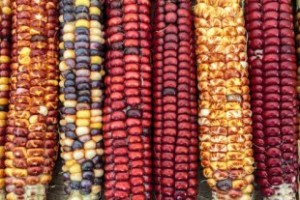Source: alternet.org
Published: August 17, 2015

Written by Leah Penniman
Affectionately called “Professor” by his neighbors, Josefino Martinez is a well-respected indigenous farmer and community organizer from the remote town of Chicahuaxtla, in the Mexican state of Oaxaca. He watched with patient attention as I showed him photographs of Soul Fire Farm, my family’s organic farm in the mountains of upstate New York.
I tried to convince Martinez that our farms had a lot in common. “Like you, we have marginal mountain soils and steep slopes, and we’ve worked for years to build up the fertility,” I explained.
Martinez finished his simple breakfast of fresh corn tortillas with black beans. Then he rose, donned his baseball cap and undersized school backpack, and took me out to see the land he cultivates. I quickly came to understand that my idea of “marginal soils” and “steep slopes” were naive, if not laughable. It was the height of the dry season and Martinez’s land was hard, brittle, and gray. The farm was literally etched into the mountainside, with a slope so severe that plowing with tractors or animals was impossible. Yet his storage room was full of maize, beans, dried chili, squash seeds, and fresh fruit that he’d grown right here.
When I asked how this was possible, Martinez explained that he simply farmed in the manner of his ancestors, the indigenous Triqui people.
Western agronomists would have us believe that Triqui farming practices are irrelevant today, but I thought they might be part of the solution to the nascent global food crisis. I spent the first half of 2015 in southern Mexico on a Fulbright fellowship to exchange ideas with indigenous farmers like Martinez on how get long-term high yields out of difficult farmland. I was fed up with our society’s obsession with corporate, industrial agriculture, which is flooding vulnerable communities with unhealthy food, destroying natural resources, and undermining the independent family farm.
According to a detailed report by my favorite think tank, the World Resources Institute, the first thing to know about the impending food crisis is that the human population is expected to reach 9.6 billion by 2050. That’s a 37 percent increase from 2012, when it reached 7 billion. Even imagining massive redistribution of food resources, the world will need to produce 69 percent more calories by 2050 to feed all those people.
But agriculture already accounts for a nearly a quarter of greenhouse gas emissions and 70 percent of freshwater use globally. So if we simply increased the scale of what we’re doing now, the ecological effects would be catastrophic. The report goes on to describe a “menu of solutions” that farmers can follow in the future to grow more food without using additional land, water, and fuel.
I had a hunch that rural farmers in Mexico were already modeling some of these practices and not being credited. While it was difficult to leave behind the daily responsibilities of tending the land, I knew that only grassroots farmer-to-farmer exchange could solve the world’s food crisis. So, with my husband and children at my side, I left behind our farm in New York and traversed the windy mountain roads of Oaxaca to trade ideas on how to feed our communities with dignity and take care of the earth at the same time.
What I learned gave me hope. Here are three items from WRI’s list of solutions that the farmers I met are already doing—and one that isn’t on their list but probably should be.
1. Farm like a forest
Not accounting for land covered by water, desert, or ice, about half of the planet is dedicated to pasture and croplands, according to WRI’s study. And the continued expansion of agricultural land is driving biodiversity loss and ecosystem degradation. According to the U.N. Food and Agriculture Organization, an increase in “cropping intensity” could avert the need to clear an additional 62 million hectares for crops by 2050. That’s an area about the size of France. In other words, farmers need to start growing different plants one after another on the same land, as well as growing them closer together at the same time, a practice known as intercropping.
2. Eat low on the food chain
Aside from the detrimental health effects of getting our protein from animal products, it’s also highly inefficient. Poultry is the most efficient conventional source of meat, and still only converts 11 percent of its feed energy into human food. Beef cows convert only 1 percent and are major contributors of greenhouse gases. Shifting toward plant and insect-based protein sources is part of the sustainable food solution.
3. Restore health to damaged land
Cropland can expand at low environmental cost if the encroached lands do not have much natural potential to store carbon or support biodiversity. The arid Mixteca region of Oaxaca meets these criteria and has been termed an “ecological disaster zone” by the World Bank. Soil erosion and depletion has damaged about one million acres of cropland, and corn productivity rates have plummeted to the lowest in Mexico.
4. Cultivate reverence for the planet
One essential element missing from the World Resource Institute’s otherwise thorough and brilliant “menu of solutions” for the global food crisis was the ethical perspective that co-evolved with best practices in environmental management. This ethic, known as convivencia,or “living together” with both our human and natural communities, is best summarized by Kiado Cruz, a Zapotec farmer from the Oaxacan town of Yagavila:
